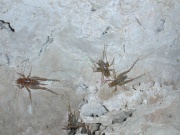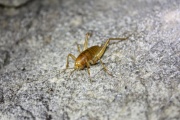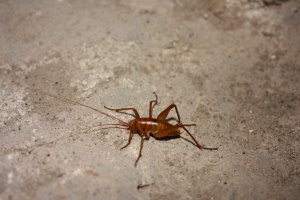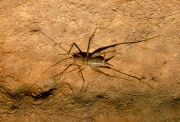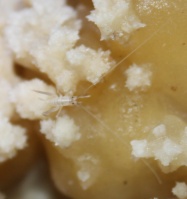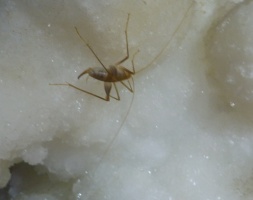Invertebrates (Inventory)/Crickets
From LagWiki
Contents |
C. conicaudus
The C. conicaudus field should be used to record stations where the ceuthophilus conicaudus species of cave camel cricket is observed.
C. conicaudus can be identified by an interrupted pattern on the back and legs with distinct spikes. Some say it looks like they are wearing argyle stockings. C. conicaudus is less cave adapted than c. longipes; but, moreso than c. carlsbadensis.
They have been found in Spider Cave and a few in Left Hand Tunnel but they could be found anywhere.
They are usually slow moving and can be seen on the walls, floor or breakdown. Observe closely and carefully to see them as they can sometimes be found in small cracks or vugs.
See also
References
- Pate, Dale. Canyons & Caves; Issue No. 20; Spring 2001; Cave Crickets: http://www.nps.gov/cave/planyourvisit/upload/c&c20.pdf
C. carlsbadensis
The C. carlsbadensis field should be used to record stations where the ceuthophilus carlsbadensis species of cricket is observed.
Larger than longipes and darker in color, this cave camel cricket is reddish brown with a noticeably humped back. The antennae are not exceptionally long and they have two dark black eyes which appear as dots on the head. They are usually slow moving and can be seen on the walls, floor or breakdown. Observe closely and carefully to see them as they can sometimes be found in small cracks or vugs.
The least cave adapted of the three camel crickets on the CCNP Cave Inventory Form, c. carlsbadensis lives in food rich areas.
See also
References
- Pate, Dale. Canyons & Caves; Issue No. 20; Spring 2001; Cave Crickets: http://www.nps.gov/cave/planyourvisit/upload/c&c20.pdf
C. carlsbadensis, Crickets, Invertebrates
C. longipes
The C. longipes field should be used to record stations where the ceuthophilus longipes (pronounced lonjipees) species of cave camel cricket is observed.
The primary distinguishing feature of c. longipes is long antennae and long legs. It is a small cricket whose color can range from translucent to brown. The size can vary from quite small (usually adolescent) to medium sized but (unless injured) will almost always have exceptionally long antennae. They have long, slender legs with fine leg spines. The females have a long ovipositor. They are usually slow moving and can be seen on the walls, floor or breakdown. Observe closely and carefully to see them as they can sometimes be found in small cracks or vugs.
C. longipes is smaller than c. carlsbadensis and lighter in color with longer antennae. They are the most cave adapted of the three species of crickets on the CCNP Cave Inventory Form and can live in areas of the cave that are poor in food.
See also
References
- Pate, Dale. Canyons & Caves; Issue No. 20; Spring 2001; Cave Crickets: http://www.nps.gov/cave/planyourvisit/upload/c&c20.pdf
C. longipes, Crickets, Invertebrates
